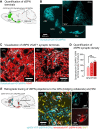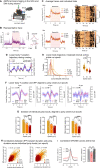A non-canonical striatopallidal Go pathway that supports motor control
- PMID: 37872145
- PMCID: PMC10593790
- DOI: 10.1038/s41467-023-42288-1
A non-canonical striatopallidal Go pathway that supports motor control
Abstract
In the classical model of the basal ganglia, direct pathway striatal projection neurons (dSPNs) send projections to the substantia nigra (SNr) and entopeduncular nucleus to regulate motor function. Recent studies have re-established that dSPNs also possess axon collaterals within the globus pallidus (GPe) (bridging collaterals), yet the significance of these collaterals for behavior is unknown. Here we use in vivo optical and chemogenetic tools combined with deep learning approaches in mice to dissect the roles of dSPN GPe collaterals in motor function. We find that dSPNs projecting to the SNr send synchronous motor-related information to the GPe via axon collaterals. Inhibition of native activity in dSPN GPe terminals impairs motor activity and function via regulation of Npas1 neurons. We propose a model by which dSPN GPe axon collaterals (striatopallidal Go pathway) act in concert with the canonical terminals in the SNr to support motor control by inhibiting Npas1 neurons.
© 2023. Springer Nature Limited.
Conflict of interest statement
J.B. and M.M. (individuals) are listed as inventors on an application (62/627,527) filed with the U.S. Patent Office regarding DREADD compounds, but none of these compounds are used in the manuscript. M.M. has received research funding from AstraZeneca, Redpin Therapeutics, and Attune Neurosciences. J.V.-V. has served on advisory boards for Roche, Novartis, and SynapDx; has received research funding from Roche, Novartis, SynapDx, Forest, Janssen, Yamo, MapLight, and Seaside Therapeutics; and has received editorial stipends from Wiley and Springer. O.Y. (indiviual) is listed as an inventor on a patent application (US20210403518A1) filed with the US Patent Office regarding the optogenetic tool eOPN3 used in Fig. 7 and Fig. S8, and serves as a consultant for Modulight.bio. Remaining authors declare no competing interests.
Figures









Update of
-
A non-canonical striatopallidal "Go" pathway that supports motor control.Res Sq [Preprint]. 2023 Feb 11:rs.3.rs-2524816. doi: 10.21203/rs.3.rs-2524816/v1. Res Sq. 2023. Update in: Nat Commun. 2023 Oct 23;14(1):6712. doi: 10.1038/s41467-023-42288-1. PMID: 36798372 Free PMC article. Updated. Preprint.
References
-
- Klaus A, Alves da Silva J, Costa RM. What, if, and when to move: basal ganglia circuits and self-paced action initiation. Annu. Rev. Neurosci. 2019;42:459–483. - PubMed
Publication types
MeSH terms
Substances
Grants and funding
LinkOut - more resources
Full Text Sources
Molecular Biology Databases

